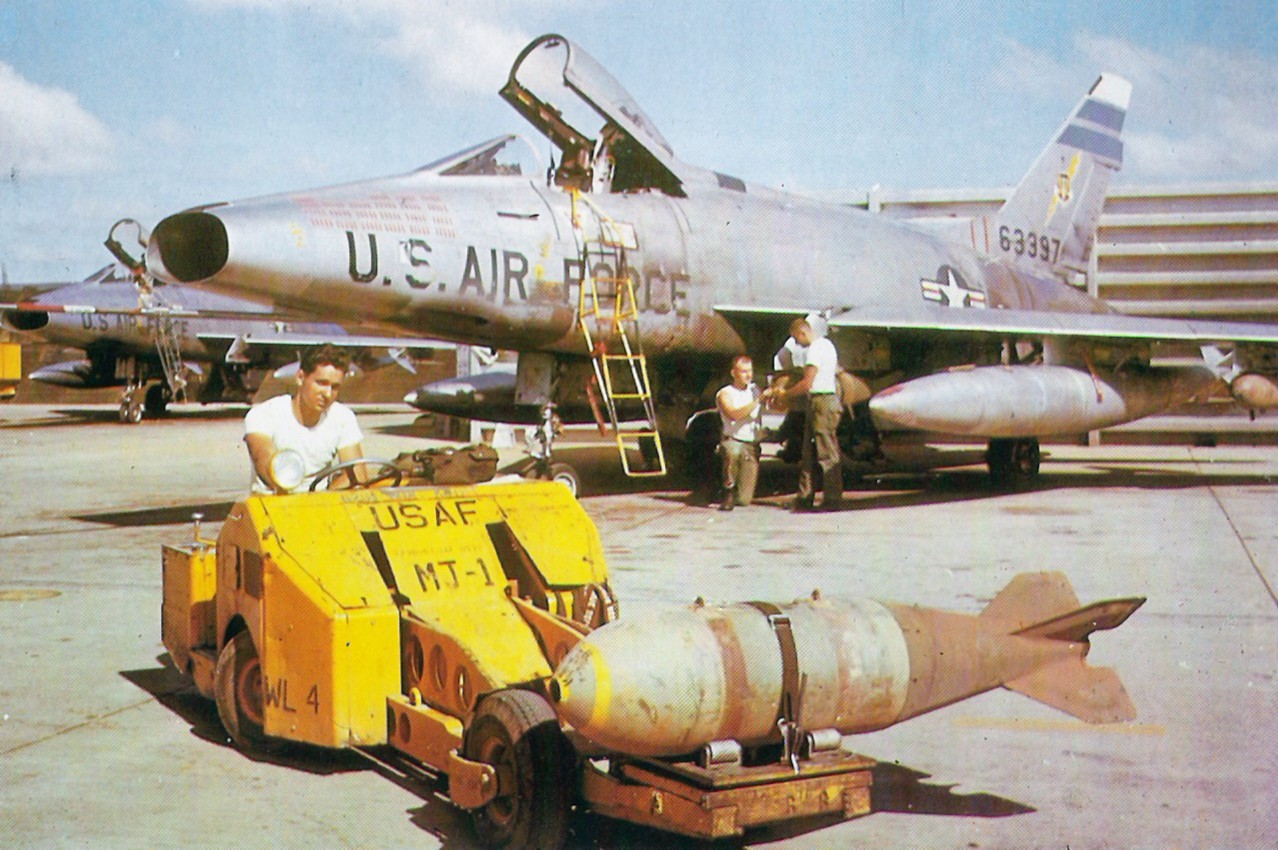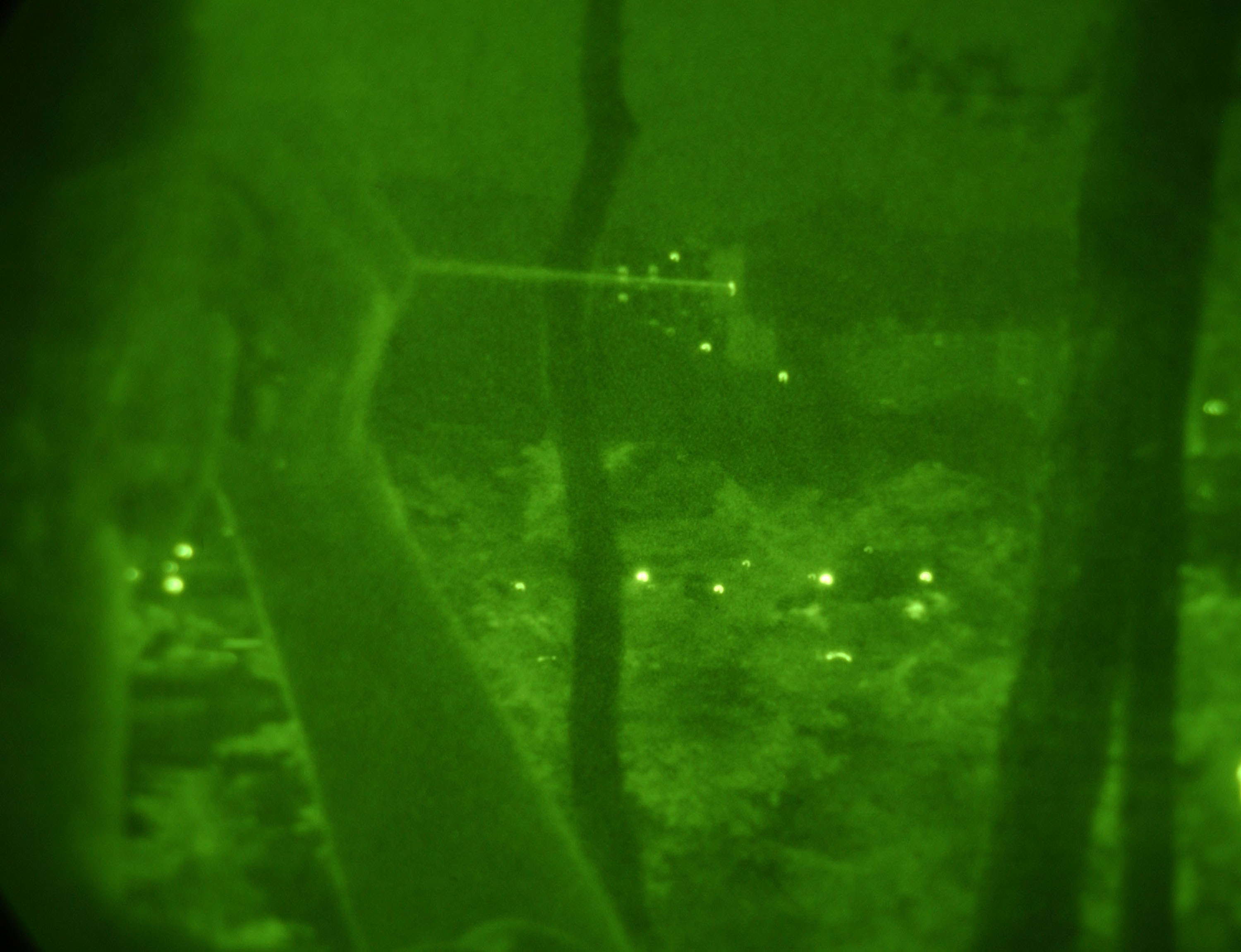|
BOLT-117
The Texas Instruments BOLT-117 (BOmb, Laser Terminal-117), retrospectively redesignated as the GBU-1/B (Guided Bomb Unit) was the world's first laser-guided bomb (LGB). It consisted of a standard M117 bomb case with a KMU-342 laser guidance and control kit. This consisted of a gimballed laser seeker on the front of the bomb and tail and control fins to guide the bomb to the target. The latter used the bang-bang method of control where each control surface was either straight or fully deflected. This was inefficient aerodynamically, but reduced costs and minimized demands on the primitive onboard electronics. Originally the project began as a surface-to-air missile seeker developed by Texas Instruments (TI). When TI executive Glenn E. Penisten attempted to sell the new technology to the United States Air Force (USAF), Colonel Joe Davis Jr. inquired if it could instead be used as a ground attack system to overcome problems US aircraft were having with the poor accuracy of bombi ... [...More Info...] [...Related Items...] OR: [Wikipedia] [Google] [Baidu] |
Precision-guided Munition
A precision-guided munition (PGM, smart weapon, smart munition, smart bomb) is a guided munition intended to precisely hit a specific target, to minimize collateral damage and increase lethality against intended targets. During the First Gulf War guided munitions accounted for only 9% of weapons fired, but accounted for 75% of all successful hits. Despite guided weapons generally being used on more difficult targets, they were still 35 times more likely to destroy their targets per weapon dropped. Because the damage effects of explosive weapons decrease with distance due to an inverse cube law, even modest improvements in accuracy (hence reduction in miss distance) enable a target to be attacked with fewer or smaller bombs. Thus, even if some guided bombs miss, fewer air crews are put at risk and the harm to civilians and the amount of collateral damage may be reduced. The advent of precision-guided munitions resulted in the renaming of older, low-technology, bombs as " un ... [...More Info...] [...Related Items...] OR: [Wikipedia] [Google] [Baidu] |
Texas Instruments
Texas Instruments Incorporated (TI) is an American technology company headquartered in Dallas, Texas, that designs and manufactures semiconductors and various integrated circuits, which it sells to electronics designers and manufacturers globally. It is one of the top 10 semiconductor companies worldwide based on sales volume. The company's focus is on developing analog chips and embedded processors, which account for more than 80% of its revenue. TI also produces TI digital light processing technology and education technology products including calculators, microcontrollers, and multi-core processors. The company holds 45,000 patents worldwide as of 2016. Texas Instruments emerged in 1951 after a reorganization of Geophysical Service Incorporated, a company founded in 1930 that manufactured equipment for use in the seismic industry, as well as defense electronics. TI produced the world's first commercial silicon transistor in 1954, and the same year designed and manufac ... [...More Info...] [...Related Items...] OR: [Wikipedia] [Google] [Baidu] |
Paveway
Paveway is a series of laser-guided bombs (LGBs). ''Pave'' or PAVE is sometimes used as an acronym for ''precision avionics vectoring equipment''; literally, electronics for controlling the speed and direction of aircraft. Laser guidance is a form of Pave. Pave, paired with other words, is the first name for various laser systems that designate targets for LGBs, for example Pave Penny, Pave Spike, Pave Tack and Pave Knife, and for specialized military aircraft, such as AC-130U Pave Spectre, MH-53 Pave Low, and HH-60 Pave Hawk. Development The Paveway series of laser-guided bombs was developed by Texas Instruments, with the project starting in 1964. The program was conducted on a shoestring budget, but the resultant emphasis on simplicity and economical engineering proved to be a benefit, and a major advantage over other more complex guided weapons. The first test, using a M117 bomb as the warhead, took place in April 1965. Early version featured aerodynamic designs l ... [...More Info...] [...Related Items...] OR: [Wikipedia] [Google] [Baidu] |
M117 Bomb
The M117 is an air-dropped demolition bomb used by United States military forces. The weapon dates back to the Korean War of the early 1950s. Although it has a nominal weight of its actual weight, depending on fuze and retardation options, can be around . The bomb's explosive content is typically of Tritonal or of Minol in the case of the M117A1E2 due to their higher density and detonation velocity compared to TNT. Demolition bombs rely on time delayed fuzes which allow the bomb to burrow into a building or other structure before detonating. The M117 can be configured with a conical low-drag tail for medium and high altitude deliveries or a high-drag tail fin for low-altitude drops, delaying the bombs hitting their targets ensuring fighters are out of the blast zone before detonation. [...More Info...] [...Related Items...] OR: [Wikipedia] [Google] [Baidu] |
Laser Guidance
Laser guidance directs a robotics system to a target position by means of a laser beam. The laser guidance of a robot is accomplished by projecting a laser light, image processing and communication to improve the accuracy of guidance. The key idea is to show goal positions to the robot by laser light projection instead of communicating them numerically. This intuitive interface simplifies directing the robot while the visual feedback improves the positioning accuracy and allows for implicit localization. The guidance system may serve also as a mediator for cooperative multiple robots. Examples of proof-of-concept experiments of directing a robot by a laser pointer are shown on video. Laser guidance spans areas of robotics, computer vision, user interface, video games, communication and smart home technologies. Commercial systems Samsung Electronics Co., Ltd. may have been using this technology in robotic vacuum cleaners since 2014. Google Inc. applied for a ... [...More Info...] [...Related Items...] OR: [Wikipedia] [Google] [Baidu] |
Laser Designator
A laser designator is a laser light source which is used to designate a target. Laser designators provide targeting for laser-guided bombs, missiles, or precision artillery munitions, such as the Paveway series of bombs, AGM-114 Hellfire, or the M712 Copperhead round, respectively. When a target is marked by a designator, the beam is invisible and does not shine continuously. Instead, a series of coded laser pulses, also called PRF codes ( pulse repetition frequency), are fired at the target. These signals bounce off the target into the sky, where they are detected by the seeker on the laser-guided munition, which steers itself towards the centre of the reflected signal. Unless the people being targeted possess laser detection equipment or can hear aircraft overhead, it is extremely difficult for them to determine whether they are being marked. Laser designators work best in clear atmospheric conditions. Cloud cover, rain or smoke can make reliable designation of targets di ... [...More Info...] [...Related Items...] OR: [Wikipedia] [Google] [Baidu] |
Weapon Guidance
Missile guidance refers to a variety of methods of guiding a missile or a guided bomb to its intended target. The missile's target accuracy is a critical factor for its effectiveness. Guidance systems improve missile accuracy by improving its Probability of Guidance (Pg). These guidance technologies can generally be divided up into a number of categories, with the broadest categories being "active", "passive", and "preset" guidance. Missiles and guided bombs generally use similar types of guidance system, the difference between the two being that missiles are powered by an onboard engine, whereas guided bombs rely on the speed and height of the launch aircraft for propulsion. History The concept of unmanned guidance originated at least as early as World War I, with the idea of remotely guiding an airplane bomb onto a target, such as the systems developed for the first powered drones by Archibald Low (The Father of Radio Guidance). In World War II, guided missiles were first d ... [...More Info...] [...Related Items...] OR: [Wikipedia] [Google] [Baidu] |
Cold War Aerial Bombs Of The United States
Cold is the presence of low temperature, especially in the atmosphere. In common usage, cold is often a subjective perception. A lower bound to temperature is absolute zero, defined as 0.00K on the Kelvin scale, an absolute thermodynamic temperature scale. This corresponds to on the Celsius scale, on the Fahrenheit scale, and on the Rankine scale. Since temperature relates to the thermal energy held by an object or a sample of matter, which is the kinetic energy of the random motion of the particle constituents of matter, an object will have less thermal energy when it is colder and more when it is hotter. If it were possible to cool a system to absolute zero, all motion of the particles in a sample of matter would cease and they would be at complete rest in the classical sense. The object could be described as having zero thermal energy. Microscopically in the description of quantum mechanics, however, matter still has zero-point energy even at absolute zero, because ... [...More Info...] [...Related Items...] OR: [Wikipedia] [Google] [Baidu] |
Unguided Bomb
An unguided bomb, also known as a free-fall bomb, gravity bomb, dumb bomb, or iron bomb, is a conventional or nuclear aircraft-delivered bomb that does not contain a guidance system and hence simply follows a ballistic trajectory. This described all aircraft bombs in general service until the latter half of World War II, and the vast majority until the late 1980s. Then, with the dramatically increased use of precision-guided munitions, a retronym was needed to separate "smart bombs" from free-fall bombs. "Dumb bomb" was used for a time, but many military circles felt it sounded too trite, and eventually "gravity bomb" gained popularity. Bomb casings for unguided bombs are typically aerodynamic in shape, often with fins at the tail section, which reduce drag and increase stability after release, both of which serve to improve accuracy and consistency of trajectory. Unguided bombs typically use a contact fuze for detonation upon impact, or some milliseconds after if a penetrati ... [...More Info...] [...Related Items...] OR: [Wikipedia] [Google] [Baidu] |
Naval Historical Center
The Naval History and Heritage Command, formerly the Naval Historical Center, is an Echelon II command responsible for the preservation, analysis, and dissemination of U.S. naval history and heritage located at the historic Washington Navy Yard. The NHHC is composed of 42 facilities in 13 geographic locations including the Navy Department Library, 10 museums and 1 heritage center, USS ''Constitution'' repair facility and detachment, and historic ship ex-USS ''Nautilus''. Command history The Naval History and Heritage Command traces its lineage to 1800, when President John Adams requested Benjamin Stoddert, the first Secretary of the Navy, prepare a catalog of professional books for use in the Secretary's office. When the British invaded Washington in 1814, this collection, containing the finest works on naval history from America and abroad, was rushed to safety outside the Federal City. After that, the library had many locations, including a specially designed space in the St ... [...More Info...] [...Related Items...] OR: [Wikipedia] [Google] [Baidu] |
John Darrell Sherwood
John Darrell Sherwood (born 1966) is an American author who has published five books and numerous articles. He specializes in military history, but has also published articles on travel and skiing. He has been with the Naval History and Heritage Command since 1997. Education Sherwood graduated from Milton Academy in 1985, and received his B.A. from Columbia University and Ph.D. from George Washington University. He was a Fulbright scholar to Germany and Greece in 2019. Officers in Flight Suits His first book, ''Officers in Flights Suits: The Story of American Air Force Fighter Pilots in the Korean War'' (1996), examines the personal wartime experiences of U.S. Air Force fighter pilots in the Korean War. In 1996, it was selected to be on the Air Force Chief of Staff's professional reading list. Fast Movers His second history, ''Fast Movers: Jet Pilots and the Vietnam Experience''(1999), focuses on U.S. Air Force, U.S. Navy, and U.S. Marine Corps fighter pilots who fought in ... [...More Info...] [...Related Items...] OR: [Wikipedia] [Google] [Baidu] |
AGM-62 Walleye
The AGM-62 Walleye is a television-guided glide bomb which was produced by Martin Marietta and used by the United States Armed Forces from the 1960s-1990s. Most had a 250 lb (113 kg) high-explosive warhead; some had a nuclear warhead. The designation of the ''Walleye'' as an "air-to-ground missile" is a misnomer, as it is an unpowered bomb with guidance avionics, similar to the more modern GBU-15. The Walleye was superseded by the AGM-65 Maverick. History The Walleye was the first of a family of precision-guided munitions designed to hit targets with minimal collateral damage. This "smart bomb" had no propulsion system, but it could be maneuvered via a television assisted guidance system during its glide from an aircraft to the target. As a pilot dived towards a target, a television camera in the nose of the bomb transmitted images to a monitor in the cockpit. Once the pilot acquired a sharp image of the target on his screen, he designated an aim point and released t ... [...More Info...] [...Related Items...] OR: [Wikipedia] [Google] [Baidu] |






.jpg)


